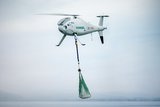MQ-1C surpasses flight test goal
General Atomics Aeronautical Systems’ (GA-ASI's) MQ-1C Gray Eagle Extended Range UAS has flown for more than 40 hours during an endurance flight test, the company announced on 24 August.
The UAS was configured for a representative US Army mission and flew 41.9 hours out of El Mirage, California.
It marked the aircraft’s 43rd test flight since 29 October 2016.
The UAS will begin flying in Dugway, Utah, in late August as part of the army’s First Article Test to further demonstrate aircraft range, endurance and payload capacity.
The MQ-1C Extended Range will go through logistics demonstrations in January 2018 where aircraft maintainability will be validated. In March 2018, the aircraft's ability to meet all army operational requirements will be tested in preparation for fielding. Fielding is planned for August 2018.
Related Equipment in Defence Insight
More from Uncrewed Vehicles
-
Jammer resistant drone designs spark search for countermeasures
The Russia-Ukraine conflict has driven another stage of evolution for drones and the counter measures to defend against them.
-
![L3Harris launches Amorphous software for control of uncrewed platforms]()
L3Harris launches Amorphous software for control of uncrewed platforms
The new Amorphous software is a universal controller that would allow a single operator to control a swarm of “thousands” of uncrewed systems, from drones to underwater platforms.
-
ideaForge unveils new UAVs at Aero India 2025
India UAV supplier ideaForge has launched the Netra 5 and Switch V2 drones at Aero India 2025, boasting of enhanced endurance, AI-driven autonomy and improved operational capabilities.
-
![Shaping the future of defence: What 2025 holds for the global drone market]()
Shaping the future of defence: What 2025 holds for the global drone market
The UAV market is experiencing unprecedented growth, with innovations in technology and battlefield applications driving demand across military sectors. From the battlefields of Ukraine to NATO exercises and beyond, drones are transforming how wars are fought and supported.
-
![Maris-Tech confirms customers signing up for Jupiter Drones codec and AI-powered system]()
Maris-Tech confirms customers signing up for Jupiter Drones codec and AI-powered system
Launched at AUSA in October, the company’s multi-stream video codec is attempting to bring a new lease of life to drone technology through its AI accelerator.
-
![AUSA 2024: Quantum-Systems targets big 2025 with UAS developments]()
AUSA 2024: Quantum-Systems targets big 2025 with UAS developments
Quantum-Systems has been upgrading its UAS family, with new versions of the Vector, Reliant and Twister drones set for release throughout 2025.
























